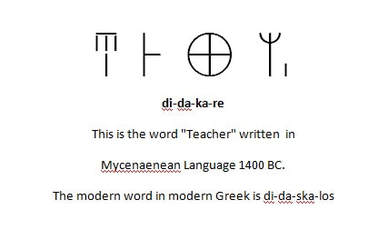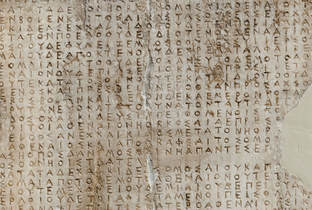 The resemblance of ancient Greek (2600 years ago) with modern Greek language is very big. The language that Socrates taught his students and Plato taught in the Academia is very much resembling our modern Greek. Moreover, M. Ventris very recently (1952) discovered the resemblance of linear Mycenaean language with the Ancient Greek Language.  The ancient letters were always capitals, although in modern Greek we have small and capital letters (like in most languages). Another difference is that in ancient Greek all the words are written without spaces between them. In modern Greek there are spaces between the words, so the reading is made easier. Even though we have all these differences it is very interesting that I, as a modern Greek, without having any knowledge of ancient Greek, can understand what an inscription in ancient Greek language is about. We recognize the letters because we use almost exactly the same alphabet and we roughly understand the meaning without any additional knowledge. This is when one realizes that it is the same language although 2600 years have passed. Of course, after all these years many things are different. It is very similar to English people when trying to read Shakespeare from the manuscript although this might be easier because only 500 years have passed since then, but it is a similar case. One incredible thing is that Greece is a place where there are ancient items and inscriptions everywhere, not only in the museums but in the fields, too. You may walk in a field of olive trees and suddenly you may see some ancient inscriptions between two olive trees which might refer to Alexander the Great, for example. Most of the Greeks, if they look closely at the inscriptions, will be able to read them and they will understand the meaning of the writings. The only pre-condition is to know at least the modern Greek language. This is happening because from 500 BC until 100 A.C. Greek language was a universal language of the world, and this is why the Holy Bible has been written in Greek, too. It was like English today. The Romans who conquered Greece had a great respect to Greek language, Greek philosophy, Greek mathematicians, Greek theater and arts, and Greek civilization in general. They showed great respect to all this. So the spirit and the language stayed alive for many hundred years more. This may be the reason why the Roman Empire transformed to the Byzantine Empire (East Roman Empire) after 300 A.C. and the Byzantine empire carried on the Greek language again for 1100 years more until 1453 A.C. Free areas like Crete and Heraklion, that was a very important Venetian port, were among the latest cities that the Ottomans conquered (almost 200 years after Kostantinopoli). During the Renaissance in Europe, European philosophers, scientists and artists (after the Middle Ages in Europe) met again with the ancient Greek civilization and inspired themselves again by reading the Greek texts of the great philosophers of antiquity, such as Socrates etc. This is the reason Greece has such a deep cultural connection with Europe although it is far more south and east in the map. Of course, after the freedom came to Greece again in the early 19th century (after almost 200 years for Crete, which is a very tiny quantity of time compared with history from ancient times) the Greek language and population were starting to flourish again in all the free areas. So, we have a continuity of 2600 years (from 600 B.C. until now) of spoken and written Greek that allows us, the modern Greeks, to understand the letters and the meaning of ancient inscriptions without any additional or formal education in ancient Greek inscriptions. How crazy is that! But the most crazy thing in this story is that before Ancient Greeks and before 1000 B.C., in the same geographical area there was another ancient civilization (between 1400 B.C. until almost 1000 B.C.), the Mycenaean Greek civilization (between 1000 B.C. and 600 B.C. there are the Greek Dark Ages that we do not have much information about). The epic poems Homer recites were about this period of time, inside the Mycenaean civilization between 1400 and 1000 B.C. The writings of this previous civilization were in the Linear B (Mycenaika) language and they consisted of ideographs (like Chinese). Every ideogram was comprised of one syllable like -ta, -di, -me, se, la, -ra etc. The most of the inscriptions in Mycenaika have been found in Crete (more than 80,000 pieces of inscriptions) where the last period of Minoan civilization (2700 until 1100 B.C.) had been merged with Mycenaean civilization. This Mycenaean language is very similar with the Minoan language (Grammiki A), although we cannot read Linear A yet. But Mycenaean language (linear B) was first decoded in 1952 by the English Michael Ventris with the help of John Chadwick. What Ventris discovered was that the Mycenaean language was a primitive Ancient Greek language. The ideograms were completely different from the ancient Greek letters, but if you transform the ideograms into sounds (because Ventris decoded them) then you could notice a resemblance not only to the Ancient Greek Language but also to the modern Greek Language. So, for example, "di-da-ka-re" means Teacher in the Mycenaean language. The modern Greek word for teacher is "δι-δα-σκα-λος" or in the Latin transliteration "di-da-ska-los") where in the Mycenaean language (3400 years ago) as we saw above, it was di-da-ka-re. Consider also that in Mycenaean language ''s'' when followed by a consonant is remitted and also syllables with ''r'' were the same with syllables with ''l'' (re=le). There are many other resemblances. So, Mycenaean language connects Minoan Civilization, the first European civilization, with Greek Civilization and culture. That is a continuity of Greek Language and history at least for 3400 years in a row.
0 Comments
Your comment will be posted after it is approved.
Leave a Reply. |
Archives
April 2023
Categories
All
|
Location
|
AWARDs
|
|
 RSS Feed
RSS Feed

